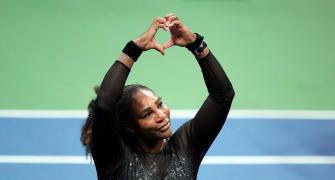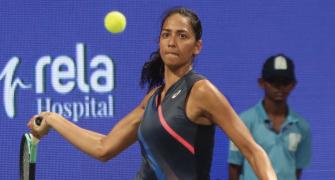Federer, Nadal and Djokovic had made it near impossible for their peers to live, and thrive, amongst them.
But the coming generation, which hasn't been as scarred by defeat at the hands of the Big 3, may make tennis unpredictable again.
Deepti Patwardhan begins a new sports column.

A few hours ahead of the Paris Masters final, a photograph was doing the rounds.
It was from six years ago of a 13-year-old Holger Rune posing with the 29-year-old Novak Djokovic, a fan-boy smile plastered on the Dane's face.
On Sunday, in front of a raucous Parisian crowd, against the most successful Masters 1000 player in tennis history, Rune went from fan, to rival, to conqueror.
In an intense two-hour 33-minute contest, he defeated Djokovic 3-6, 6-3, 7-5.
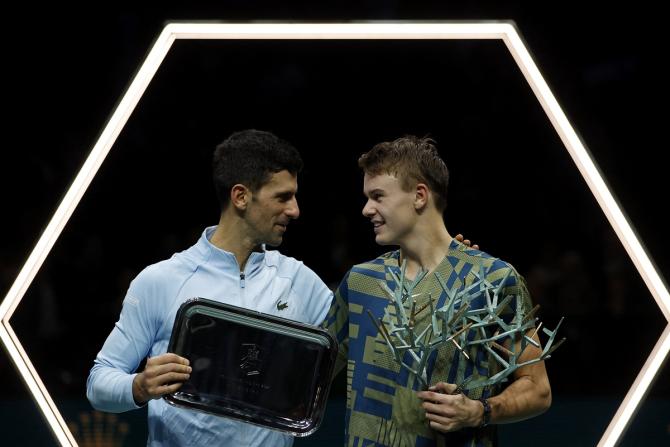
Djokovic, the 21-time Grand Slam champion, had won 30 of the 30 Masters finals when he had clinched the first set.
He held a 3-1 lead over Rune in the deciding set; he also had six break opportunities in a remarkable 16-minute final game. But Rune found a way past every single time.
'I just tried to use my young power, willpower, to do everything I can to put him under pressure,' Rune said in the aftermath.
'Young power', the bravado you associate with youth, was somewhat scarce in men's tennis over the past decade-and-a-half, as the Big 3 -- Roger Federer, Rafael Nadal and Djokovic -- dominated thoroughly. But 2022 has been a year of upheaval in tennis.
Legends like Federer and Serena Williams have bowed out. Big 3 has become Big 2.
The wheels of time have turned and brought us new heroes and a world full of possibilities. Sport covets nothing more.
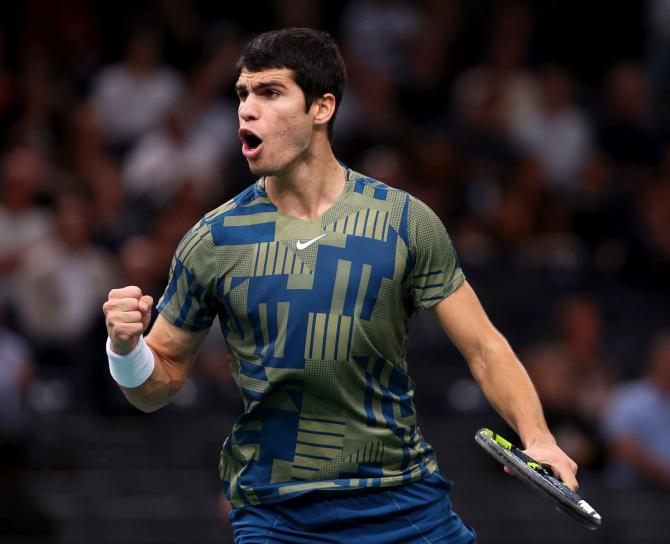
Rune's week in Paris had started with him saving three match points against Stan Wawrinka and being told by the Swiss, at the net after the match, to 'Stop acting like a baby on the court.'
In what turned out to be a coming-of-age tournament, the Dane beat five top-10 players -- Djokovic (ranked No 7), Felix Auger-Aliassime (No 8), Andrey Rublev (No 9) and Hubert Hurkacz (No 10) -- in as many days to clinch his first Masters 1000 title. The title run also saw him break into the top-10 for the very first time.
His breakthrough comes less than two months after Carlos Alcaraz rose to No 1.
The Spaniard, who has been compared to everyone from Andre Agassi to Djokovic after that one headlining week in Madrid when he defeated Nadal and Djokovic on clay, on successive days to clinch the title, proved he was Grand Slam-ready.
In the youngest Open Era final since the 1990 US Open between Andre Agassi and Pete Sampras, the teenaged Alcaraz defeated 23-year-old Casper Ruud to clinch the US Open and the top spot.
At 19 years, four months and seven days, the Spaniard became the youngest player to reach No 1 since official ATP rankings were established in 1973.
Rune rising to No 10 this week means that for the first time in over 15 years two teenagers are in the top 10.
The last time that happened was in 2007, when Djokovic and Andy Murray were part of the elite group.
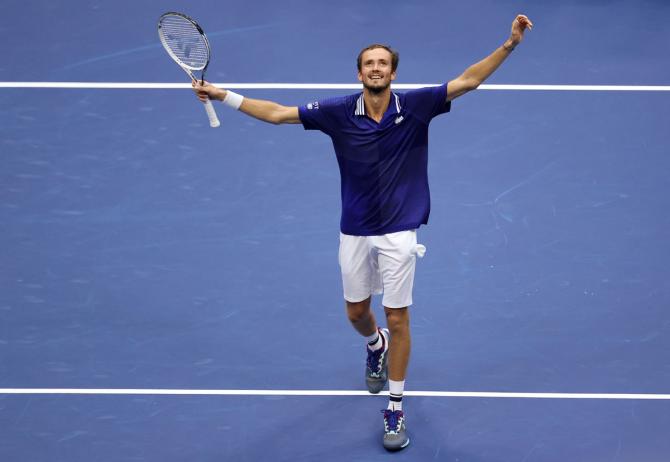
It is a far cry from a few years ago when the men's tour was mainly inhabited by hardened journeymen.
The sport, once a haven for teen prodigies, worried for its young when there were no teenaged players in the top-100 in 2010.
By April 2013, it had turned into a crisis as there were no teenagers in the top-250.
The physicality of men's tennis, the slowness of the courts, the progress in sports science had all played its part in stifling the youngsters. But armed with knowledge and more nuanced training than ever before, younger players seem to have weathered the perfect storm.
'Yes, a new generation is rising. Alcaraz, Rune, myself, we are all young, all of us,' Djokovic joked in Paris last week. But after the final, he conceded that Alcaraz and Rune are ready to take on the best, now.
'They are similar in terms of physicality. I think they are both really fit. They train very hard. They are very dedicated guys. They defend, both of them, extremely well. They have great shots, great forehand from Rune or great backhand from Alcaraz. They are very complete players for 19 year olds.'
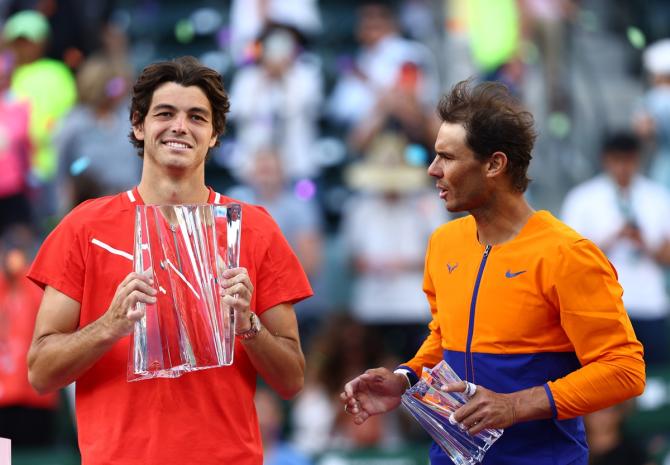
While Rune and Alcaraz's rise may have been the most spectacular, there have been little reminders of the changing times through the year.
In February, 2021 US Open champion Daniil Medvedev became the first player not named Federer, Nadal, Djokovic or Murray to take over as No 1 in the world.
On his French Open debut, Rune ruffled a few feathers as he defeated Stefanos Tsitsipas and reached the quarterfinal.
Ruud reached two Grand Slam finals in the year – at French Open and then US Open -- and reached a career-high of No 3 in the rankings.
Jannik Sinner (21) and Alcaraz gave a glimpse of a brewing rivalry as they clashed at Wimbledon and US Open -- the latter was arguably the match of the tournament.
Taylor Fritz, 25, defeated Nadal for a maiden Masters title at Indian Wells.
At the US Open, Nadal went down to 24-year-old gung-ho Frances Tiafoe.
In what may be the most honest assessment for the future of men's tennis, Tiafoe said, 'I don't think it will be a Big 3 (in the new generation). It will be like a Big 12. There's a ton of guys playing great tennis.'
Federer, Nadal and Djokovic had made it near impossible for their peers to live, and thrive, amongst them. But the coming generation, which hasn't been as scarred by defeat at the hands of the Big 3, may make tennis unpredictable again.
In the latest ATP rankings, the only players above 30 in top-10 are Nadal (36) and Djokovic. And even though they have vowed to soldier on for a few more years, they no longer look infallible.
Nadal, who won the first two majors of the year, has struggled for fitness in the second part of the year.
Meanwhile, Djokovic's refusal to take the vaccine has seen him unable to participate on the tour for a few weeks and the breaks in momentum have reflected in results.
In the Paris Masters final, Djokovic admitted he was slow to 'think on his feet' on crucial points.
The Serb possesses the best return on the tour and the best backhand. But on Sunday, Rune had 17 backhand winners to Djokovic's six and saved 10 of the 12 break points he faced.
He looked his idol in the eye and didn't blink. Young power.
Deepti Patwardhan is a freelance sports writer based in Mumbai.
Feature Presentation: Rajesh Alva/Rediff.com

